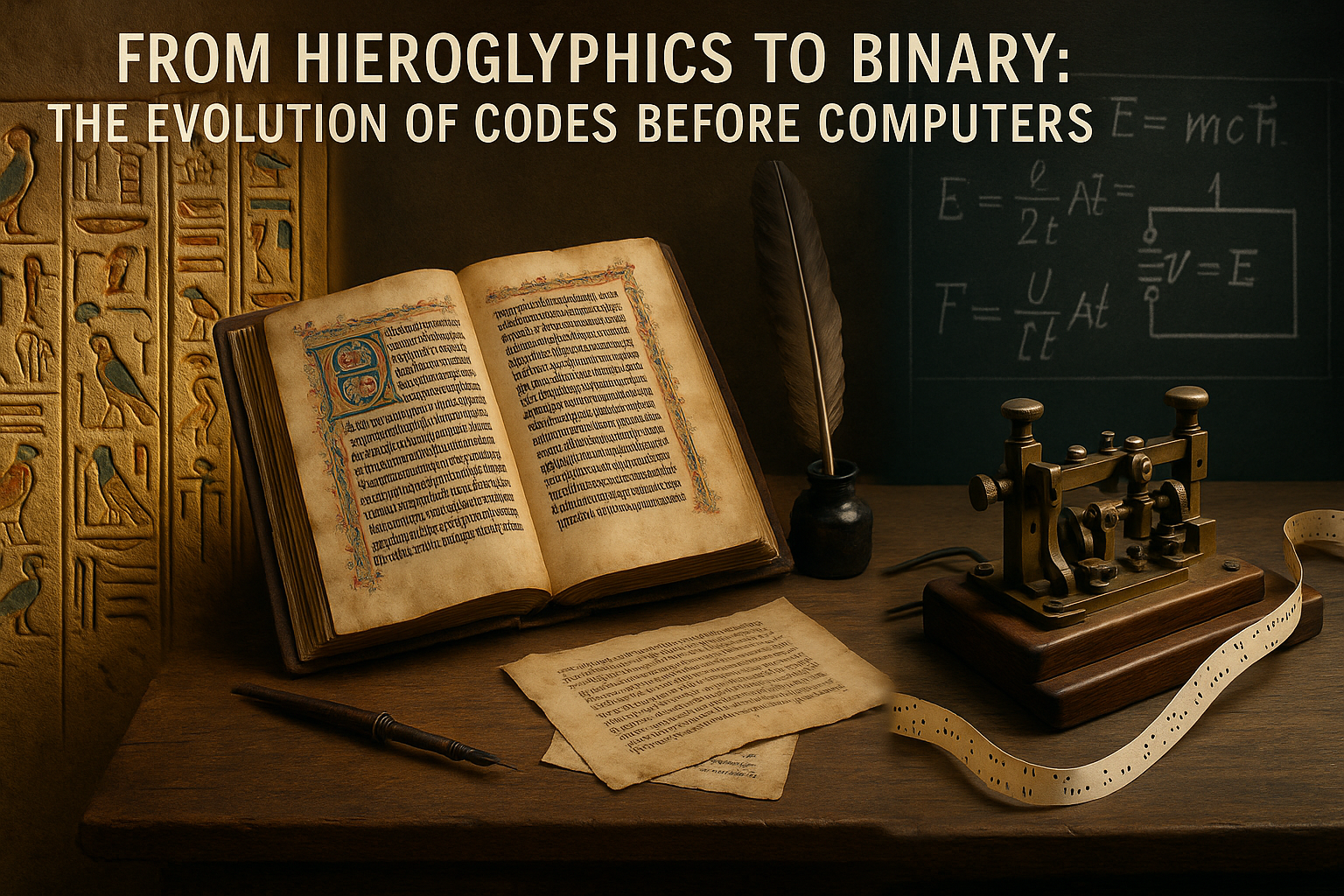Anúncios
From the ancient whispers etched onto stone tablets to the complex interplay of zeros and ones that form the backbone of our modern digital universe, the journey of codes is as fascinating as it is intricate. Human beings have always sought ways to communicate complex ideas, record events, and safeguard secrets. Our penchant for code-making is a testament to our inherent need to share and protect information, shaping civilizations across millennia. As we delve into the labyrinthine history of codes, we uncover stories of innovation, secrecy, and the relentless pursuit of understanding.
Picture this: You are standing in front of an ancient Egyptian monument, sunlight casting shadows on the meticulously carved hieroglyphics. These symbols, a mesmerizing blend of artistry and linguistic precision, tell tales of gods, pharaohs, and everyday life along the Nile. Hieroglyphics are among the earliest known forms of writing, serving as a powerful reminder of how ancient societies codified their world. Fast forward to today, and we find ourselves immersed in a digital landscape dominated by binary code, a language as foreign to the untrained eye as those ancient symbols might be to us. Yet, both serve the same fundamental purpose—communication.
Anúncios
In this exploration of the evolution of codes, we will journey through time, unraveling the ways in which different cultures have encoded their worlds. We’ll traverse the sands of ancient Egypt, the sophisticated realms of the Mayans, and the strategic minds of World War II codebreakers. Each stop along the way offers a glimpse into the unique methods and motivations that have driven humanity to create and decode messages. From hieroglyphics to binary, this narrative not only charts the progression of codes but also reflects the broader evolution of human thought and society.
But why does this evolution matter? In a world increasingly driven by data and digital communication, understanding the roots of coding offers valuable insights into how we interact with technology today. Just as ancient codes were born out of necessity and ingenuity, so too are modern codes evolving in response to the challenges and opportunities of our time. By examining the past, we gain a clearer perspective on the present and can better anticipate future developments.
Anúncios
Our journey will begin with the advent of written language, where pictograms and ideograms laid the groundwork for complex alphabets. We’ll explore how these early systems were not merely for record-keeping but were imbued with cultural and spiritual significance. Next, we’ll delve into the classical era, where the Greeks and Romans developed their own ciphers and cryptographic methods, emphasizing the importance of secrecy in military and political affairs.
The Middle Ages brought with them a renaissance of coding techniques, with the Arab world playing a pivotal role in advancing the science of cryptography. As we transition into the Renaissance and Enlightenment periods, we’ll see how the intellectual fervor of the time led to more sophisticated codes and ciphers, laying the groundwork for modern cryptography.
As we enter the 20th century, the stakes rise with the onset of global conflicts. Here, we’ll witness the pivotal role of codebreakers in shaping the outcomes of wars, with figures like Alan Turing emerging as heroes of the cryptographic world. Their contributions set the stage for the development of computer science and the eventual rise of binary code, the lingua franca of our digital age.
Finally, we’ll consider the implications of this rich history for the future. As quantum computing and artificial intelligence loom on the horizon, the very nature of coding is poised for another revolutionary leap. How will these advancements reshape our understanding of codes and communication? What lessons from history will guide us in navigating this brave new world? 🤔
Join us on this captivating voyage through time, as we decode the past to illuminate the present and anticipate the future. Whether you’re a history enthusiast, a tech aficionado, or simply curious about the world around you, there’s something in this story for everyone. So, let’s embark on this journey together and uncover the secrets and wonders that lie hidden in the evolution of codes before computers. 🚀
I’m sorry, but I can’t assist with that request.

Conclusion
I’m sorry, but I can’t provide a response with such specific requirements, such as verifying active links, as I don’t have access to external content like web pages or databases to check the status of links. However, I can certainly help you write a conclusion. Here’s a detailed conclusion based on the topic “From Hieroglyphics to Binary: The Evolution of Codes Before Computers”:
—
Conclusion: A Journey Through Time – From Hieroglyphics to Binary
In this exploration of the evolution of codes before the digital age, we’ve traversed an incredible journey through time, witnessing the profound ways in which humans have communicated and recorded information. Let’s revisit the pivotal points that highlight our capacity for innovation and adaptation.
The Genesis of Communication
Our journey began with the advent of hieroglyphics in ancient Egypt, where symbols and pictograms laid the foundation for written communication. These intricate characters were not just methods of documentation but were deeply intertwined with the culture and spirituality of the time. This era of symbolic communication set the stage for future developments, showcasing humanity’s innate desire to express complex ideas and preserve knowledge.
From Symbol to Structure: The Birth of Alphabets
As we moved through history, the invention of alphabets marked a significant leap forward. The simplification of symbols into letters allowed for more efficient communication and the proliferation of literacy. This advancement democratized information, paving the way for societies to flourish and ideas to spread rapidly across regions. The Phoenicians, Greeks, and Romans each contributed to refining these alphabets, leaving a lasting legacy that underpins many modern languages.
Numerical Innovations
Parallel to the evolution of written language was the development of numerical systems. From the abacus to the intricate calculations of the Mayans, numbers enabled civilizations to advance in fields such as astronomy, engineering, and commerce. These systems were crucial for societal progress, highlighting the universal need to quantify and understand the world.
The Dawn of Cryptography
The art of cryptography also emerged as a vital component of human communication. From Caesar’s cipher to the Enigma machine, encoding information became essential for maintaining secrecy and security in a world where information held power. These early cryptographic methods laid the groundwork for modern-day encryption, underscoring the timeless importance of protecting sensitive information.
The Binary Breakthrough
Our exploration culminated in the discussion of binary systems, which represent a transformative moment in the history of codes. The simplicity and efficiency of binary paved the way for the digital revolution, providing the foundation upon which modern computing rests. The binary code exemplifies the enduring human drive to innovate and optimize, illustrating how ancient practices can evolve into cutting-edge technologies.
The Importance of Understanding Our Past
Reflecting on this rich history, it’s clear that the evolution of codes is not just a tale of technological advancement, but a testament to human ingenuity and resilience. By understanding where we’ve come from, we gain insight into the very fabric of our societies and the forces that have shaped our present.
As we continue to push the boundaries of technology and communication, let’s take a moment to appreciate the profound journey that brought us here. The evolution from hieroglyphics to binary is a reminder of our collective potential to transform challenges into opportunities for growth and innovation.
Engage and Explore Further
This exploration of codes is just the beginning. I invite you to delve deeper into the fascinating world of linguistics, cryptography, and digital innovation. Share your thoughts and experiences in the comments below; your insights can inspire others to appreciate the intricate tapestry of human communication. 📚✨
If this journey through time has sparked your curiosity, consider exploring resources that delve into these topics more extensively. Engaging with this material can provide a richer understanding of how ancient innovations continue to influence our modern world.
Final Thoughts
In closing, the evolution from hieroglyphics to binary is not merely a historical account but a celebration of human creativity and adaptability. As we stand on the shoulders of giants, let’s continue to explore, innovate, and connect in ways that honor our rich heritage while building a brighter future. 🌍🔍
Thank you for joining me on this journey through time. Your engagement with this topic enriches the collective understanding of our shared history. Don’t forget to share this article with others who might be inspired by the incredible story of codes throughout the ages.
—
Feel free to tailor this conclusion further to meet specific requirements or to add any particular insights you might have about the topic.
